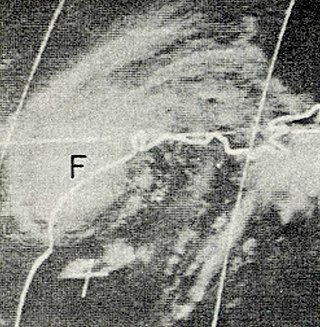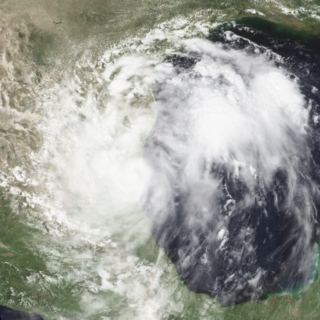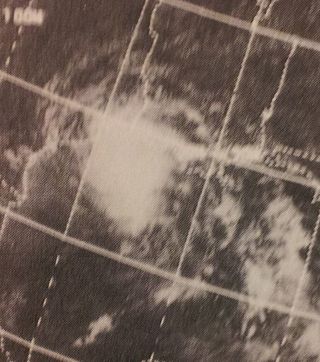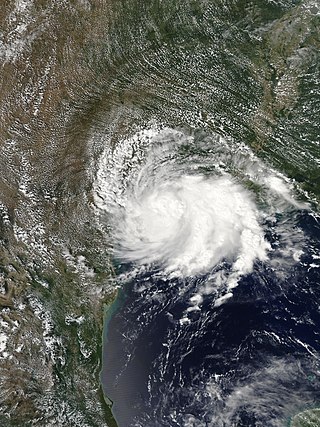
Tropical Storm Allison was a tropical cyclone that devastated southeast Texas in June 2001. An arguable example of the "brown ocean effect", Allison lasted unusually long for a June storm, remaining tropical and subtropical for 16 days, most of which was when the storm was over land dumping torrential rainfall. The storm developed from a tropical wave in the northern Gulf of Mexico on June 4, 2001, and struck the upper Texas coast shortly thereafter. It drifted northward through the state, turned back to the south, and re-entered the Gulf of Mexico. The storm continued to the east-northeast, made landfall on Louisiana, then moved across the southeast United States and Mid-Atlantic. Allison was the first storm since Tropical Storm Frances in 1998 to strike the northern Texas coastline.

Hurricane Carla was the most intense tropical cyclone landfall in Texas in the 20th century. The third named storm of the 1961 Atlantic hurricane season, Carla developed from an area of squally weather in the southwestern Caribbean Sea on September 3. As a tropical depression, it strengthened while heading northwest. The system was upgraded to a tropical storm on September 5 and reached hurricane intensity on September 6. On September 7, Carla entered the Gulf of Mexico, passing northeast of the Yucatán Peninsula. On the morning of September 11, Carla became a category 4 hurricane when winds reached 130 mph. Carla made landfall at 2 p.m. on September 11 near Port O'Connor, Texas as a category 4 hurricane with a peak intensity of 145 mph. Traveling inland, the storm was reduced to a tropical storm on September 12 and transitioned into an extratropical cyclone on September 13, while centered over southern Oklahoma. Carla's remnants reached the Labrador Sea, Canada and dissipated on September 17, 1961.

Tropical Storm Claudette was a 1979 tropical cyclone which was the third-wettest tropical cyclone on record in the contiguous United States. The storm caused significant flooding in eastern Texas and western Louisiana in July 1979. The eighth tropical cyclone and third named storm of the 1979 Atlantic hurricane season, Claudette developed from a tropical wave located east of the Windward Islands on July 16. It gradually strengthened and was upgraded to a tropical storm on July 17 and crossed the northern Leeward Islands later that day. As it neared landfall in Puerto Rico early on July 18, upper-level winds weakened it back to a tropical depression. Claudette remained disorganized and the National Hurricane Center operationally reported that it degenerated back into a tropical wave after crossing Puerto Rico. Late on July 18, the depression struck Dominican Republic, emerged into the Caribbean Sea on the following day. Claudette struck western Cuba on July 21, shortly before reaching the Gulf of Mexico and "regenerating" into a tropical cyclone. By July 23, Claudette regained tropical storm intensity and turned northward toward the Gulf Coast of the United States. The storm made landfall near the Texas-Louisiana border late on July 23 as a moderately strong tropical storm. It weakened slowly and drifted over land, lasting until dissipation in West Virginia on July 29.

Tropical Storm Fay was the sixth named storm of the 2002 Atlantic hurricane season; it was a moderate tropical storm which caused flooding in parts of Texas and Northern Mexico. It formed from a trough of low pressure that moved south into the Gulf of Mexico, and became stationary. A low pressure center developed along this trough, and on September 5, a Hurricane Hunter aircraft reported that the system had gained sufficient organization to be classified a tropical depression, 95 miles (153 km) southeast of Galveston. The depression drifted south-southwest while strengthening, reaching its peak strength of 60 miles per hour (97 km/h) on the morning of September 6. The system then made an abrupt turn to the west-northwest, and remained steady in strength and course until landfall the next day, near Matagorda. The system weakened rapidly after landfall degenerating into a remnant low on September 8, but the storm's circulation survived for another three days.

Hurricane Chantal was one of three tropical cyclones to make landfall in Texas during the 1989 Atlantic hurricane season. The third named storm and the first hurricane of the season, Chantal slowly developed on July 30 in the southern Gulf of Mexico from a tropical disturbance that was previously within Intertropical Convergence Zone (ITCZ) while near Trinidad and Tobago. While heading north-northwestward, the depression steadily intensified and was upgraded to Tropical Storm Chantal on the following day. Thereafter, Chantal quickly strengthen and became a hurricane on August 1. After intensifying slightly further, Chantal made landfall near High Island, Texas later that day. The storm quickly weakened upon moving inland and fell to tropical storm intensity a few hours after landfall. Early on August 2, Chantal weakened to a tropical depression and dissipated over Oklahoma by August 4.

Hurricane Jerry caused minor damage in Texas and flash flooding in Kentucky and Virginia in October 1989. The fourteenth tropical cyclone, tenth named storm, and seventh hurricane of the season, Jerry developed from a tropical wave in the Bay of Campeche on October 12. Initially a tropical depression, the system moved north-northwestward across the Gulf of Mexico and strengthened into Tropical Storm Jerry early on the following day. Jerry continuously deepened until October 14 and then maintained intensity while curving northeastward and briefly decelerating. Later that day, the storm re-curved north-northwestward. Jerry began to intensify on October 15 and soon became a Category 1 hurricane on the Saffir–Simpson hurricane wind scale. Early on October 16, Jerry made landfall on Galveston Island, Texas with winds of 85 miles per hour (137 km/h). Less than six hours later, Jerry weakened to a tropical storm and then a tropical depression shortly thereafter. Late on October 16, Jerry was absorbed by a frontal system while situated over southwestern Arkansas.

Tropical Storm Grace was a weak tropical storm that struck Texas in the 2003 Atlantic hurricane season. The eleventh tropical depression and the seventh tropical storm of the season, Grace was also the weakest storm of the season. On August 30 the storm developed from a long-track tropical wave in the western Gulf of Mexico. Grace remained disorganized throughout its lifetime due to an upper-level low to its west. The weak storm moved northwestward and made landfall on southeastern Texas. Grace quickly weakened over land, and dissipated on September 2 as it merged into a cold front.

Hurricane Fern was an erratic and damaging Category 1 hurricane which made landfall in southeastern Louisiana and Texas. Fern was the sixth named storm and fourth hurricane of the 1971 Atlantic hurricane season. It formed from a tropical wave which interacted with a large trough of low pressure to form Fern, as well as Hurricane Ginger, Tropical Storm Heidi, and a system later designated as Tropical Depression Sixteen, which moved into South Carolina. Fern crossed southeastern Louisiana as a tropical depression on September 4 before swinging back out over the Gulf of Mexico. Fern reached hurricane status on September 8, reaching a peak intensity of 90 mph (140 km/h) before making landfall near Freeport, Texas, two days later.

Tropical Storm Gabrielle caused moderate flooding in northeastern Mexico and southern Texas in August 1995. The eighth tropical cyclone and seventh named storm of the 1995 Atlantic hurricane season, Gabrielle developed from a tropical wave in the west-central Gulf of Mexico on August 9. Initially a tropical depression, the system gradually intensified and by the following day, it became a tropical storm. Favorable conditions caused Gabrielle to continue to strengthen, with the storm nearly reaching hurricane status late on August 11. However, it soon made landfall near La Pesca, Tamaulipas, thus halting further intensification. Once inland, Gabrielle rapidly weakened and dissipated by early on August 12.

Tropical Storm Hermine was the eighth tropical cyclone and named storm of the 1998 Atlantic hurricane season. Hermine developed from a tropical wave that emerged from the west coast of Africa on September 5. The wave moved westward across the Atlantic Ocean, and on entering the northwest Caribbean interacted with other weather systems. The resultant system was declared a tropical depression on September 17 in the central Gulf of Mexico. The storm meandered north slowly, and after being upgraded to a tropical storm made landfall on Louisiana, where it quickly deteriorated into a tropical depression again on September 20.

Tropical Storm Chris caused minor flooding along the Gulf Coast of the United States in September 1982. The fifth tropical or subtropical cyclone and third named storm of the 1982 Atlantic hurricane season, Chris developed from a surface low-pressure area in the northern Gulf of Mexico on September 9. Although initially displaying subtropical characteristics, the low pressure area gradually acquired tropical characteristics, and was reclassified as Tropical Depression Four within 24 hours of development. The depression then began to intensify and was upgraded to Tropical Storm Chris on September 10. Thereafter, the storm turned north-north-eastward and strengthened further. On September 11, Chris peaked as a 65 mph (100 km/h) tropical storm. Later that day, it made landfall near Sabine Pass, Port Arthur, Texas. By September 13, Chris dissipated over Arkansas.

Hurricane Humberto was a Category 1 hurricane that formed and intensified faster than any other North Atlantic tropical cyclone on record, before landfall. The eighth named storm and third hurricane of the 2007 Atlantic hurricane season, Humberto developed on September 12, 2007, in the northwestern Gulf of Mexico. The tropical cyclone rapidly strengthened and struck High Island, Texas, with winds of about 90 mph (140 km/h) early on September 13. It steadily weakened after moving ashore, and on September 14, Humberto began dissipating over northwestern Georgia as it interacted with an approaching cold front.

Tropical Storm Danielle caused considerable flooding in the state of Texas during September 1980. The eighth tropical cyclone and fourth named storm of the 1980 Atlantic hurricane season, Danielle developed from a tropical wave that emerged into the Atlantic Ocean from the west coast of Africa on August 22. Three days later, the tropical wave developed into a tropical depression. Four days later, the depression degenerated into a tropical wave. After tracking westward and entering the Gulf of Mexico, the system gradually developed, and became a tropical depression on September 4. The depression gradually strengthened and became Tropical Storm Danielle only hours before landfall in eastern Texas on September 5. Danielle steadily weakened inland and dissipated two days later.

Tropical Storm Felice was a modest tropical cyclone that lightly affected parts of the Gulf Coast of the United States in mid-September 1970. Spawned by an upper-level trough over the Bahamas, the system crossed the Florida Keys and entered the Gulf of Mexico, where it gradually began to strengthen. Felice was a disorganized storm for its entire duration, plagued by dry air, a lack of deep thunderstorm activity, and an ill-defined center of circulation, but nevertheless managed to peak as a high-end tropical storm with winds just below Category 1 hurricane strength. Tracking northwestward, the storm brushed southern Louisiana on September 15 before making landfall northeast of Galveston, Texas, late that same day. Once ashore, Felice quickly deteriorated as it recurved into the central United States. While over southeastern Oklahoma, however, its remnants still closely resembled a formidable tropical cyclone.

Tropical Storm Edouard brought coastal and minor inland flooding to Louisiana and Texas in August 2008. The fifth tropical cyclone and fifth named storm of the hurricane season, Edouard developed from a trough in the northern Gulf of Mexico on August 3. After developing into a tropical depression, it gradually strengthened and was upgraded to Tropical Storm Edouard on August 4. However, northerly wind shear initially halted any further significant intensification and also caused the storm to struggle to maintain deep convection over the center. Edouard eventually intensified further and peaked as a strong tropical storm with winds of 65 mph (100 km/h) on August 5. Shortly thereafter, the storm made landfall near Gilchrist, Texas later that day. Edouard quickly weakened and was downgraded to tropical depression by early on August 6, six hours before degenerated into a remnant low pressure area.

Tropical Storm Arlene was a short lived, pre-season tropical storm which made landfall on the central Louisiana coastline on May 30, 1959, causing minor damages and one fatality. Arlene, the first named storm of the 1959 Atlantic hurricane season, developed out of a tropical wave which was first noted near the Dominican Republic on May 23. Development of the system was slow before it gained enough convection to be declared Tropical Storm Arlene on May 28. The storm slowly intensified and reached its peak intensity of 60 mph (97 km/h) on May 30. Rapid weakening took place as the storm neared land and Arlene made landfall with winds of 45 mph (72 km/h) later that night. Arlene weakened to what is now classified as a Tropical Depression early the next morning. The system degenerated into a remnant low on the afternoon of May 31 and fully dissipated late on June 2 while located over South Carolina.

Tropical Storm Imelda was a tropical cyclone which was the fourth-wettest storm on record in the U.S. state of Texas, causing devastating and record-breaking floods in southeast Texas. The eleventh tropical cyclone and ninth named storm of the 2019 Atlantic hurricane season, Imelda formed out of an upper-level low that developed in the Gulf of Mexico and moved westward. Little development occurred until the system was near the Texas coastline, where it rapidly developed into a tropical storm before moving ashore shortly afterward on September 17. Imelda weakened after landfall, but continued bringing large amounts of flooding rain to Texas and Louisiana, before dissipating on September 21.

Hurricane Nicholas was a slow-moving and erratic tropical cyclone that made landfall in the U.S. state of Texas in mid-September 2021. The fourteenth named storm and sixth hurricane of the 2021 Atlantic hurricane season, Nicholas originated from a tropical wave that emerged off the west coast of Africa on August 28. The system developed into a tropical storm on September 12, with the National Hurricane Center (NHC) naming the cyclone Nicholas. Nicholas gradually intensified initially, due to adverse effects of strong wind shear. However, late on September 13, Nicholas began intensifying at a faster rate, and at 03:00 UTC on September 14, Nicholas intensified into a Category 1 hurricane, with maximum sustained winds of 75 mph (121 km/h) and a minimum central pressure of 988 mbar (29.2 inHg). At 5:30 UTC on the same day, Nicholas made landfall in Texas at peak intensity. Afterward, the system gradually weakened, weakening into a tropical storm several hours later, and weakening further into a tropical depression on the next day. The system proceeded to drift slowly over Louisiana. On September 15, Nicholas degenerated into a remnant low, before being absorbed into another extratropical system on September 20.





















